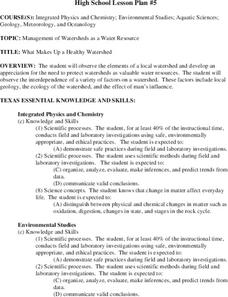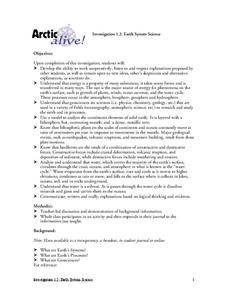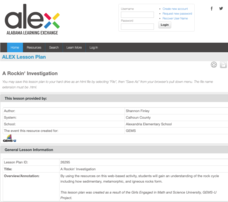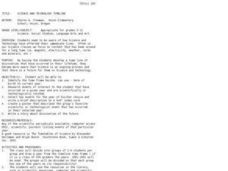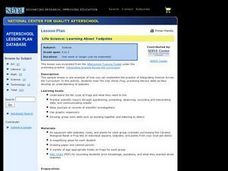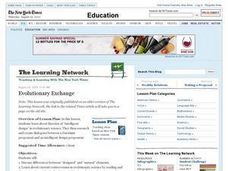Curated OER
What Makes Up a Healthy Watershed
Students, after observing the elements of a local watershed, explore the need to protect watersheds as water resources for the future. They examine the factors involved with a watershed: geology, ecology, and the effect of man's...
Curated OER
Earthquakes
Fifth graders explore the causes of earthquakes and the various types of fault lines through a variety of hands-on demonstrations using prepared cakes. They record their observations in their science journals.
Curated OER
Rocks Up!
Students will design and build a structure to support a rock. Students will use their knowledge of movement of objects to determine the proper base to be built to support their rock. Students will explore their natural area for...
Curated OER
Rock Eater
Learners examine the effects of acid rain by
performing a simulation experiment. They also view the
effects of acid rain and erosion on the reservation and record observations in a science log.
Curated OER
Earth System Science
Students explore the Earth and its ability to support life. They discuss the geosphere and the water cycle and complete the Water Wonders activity. After completing the activity, they respond in their journals and reflect upon the...
Alabama Learning Exchange
A Rockin' Investigation
Young scientists identify the rock cycle. In this earth science activity, students participate in web-based research to understand how sedimentary, metamorphic, and igneous rocks form. As a follow-up, they collect various rocks and...
Curated OER
Rockin? Chalk (Integrating science - make own chalk)
Students use plaster of Paris, talc, and cornstarch to create their own chalk. They hypothesize what mixture of ingredients produce the "best" chalk. Students discuss what they think are the characteristics of the "best" chalk.
Curated OER
Volcanoes
Students view images and interactive activities on the Internet about volcanoes. In this plate tectonics lesson, students use the Internet to view PDF images and HTML Interactive activities while writing observations in their journals....
Curated OER
Life in a Cup
Third graders make and maintain a mini terrarium. They keep a daily journal of what happens in their terrarium and record daily observations and measurements.
Curated OER
Water Properties introduction
Students list items they know and want to know about water on personal K-W-L charts. They describe what happened during the warm up activity in their science journal. Students travel to four different stations and perform the different...
Curated OER
Science and Technology Timeline
Learners develop a time line of discoveries that have occurred in their lifetime. In this time line lesson plan, students research scientifically or technologically related events of interest to them, write a brief description on a 4x6"...
Curated OER
Life Science- Learning About Tadpoles
Students investigate a frog's life cycle. For this tadpole lesson, students observe tadpoles in an aquarium and record results. Students fill in a KWL chart as an assessment.
Curated OER
Classification Introduction
Learners simulate classifying rocks using different colored skittles. In this earth science lesson, students create a Venn diagram according to their compiled information. They share this diagram in the class.
Curated OER
Erosion
Students discover the meaning of the word erosion and discuss effects of rocks and sticks upon the soil. They then work in small groups to construct a model of erosion to make observations and then write them in their science journals.
Curated OER
Solids, Liquids, and Gases
Students explore the three main forms of matter: solid, liquid, and gas. They examine concrete examples of each, using their five senses and "experimenting" to find differences in them. They find pictures of each, cut them out and past...
Curated OER
Petroglyphs: Protecting the Past
Fourth graders investigate the three types of rocks and study about petroglyphs. They explore why petroglyphs were used by the Nez Perce People. Students investigate the properties of the three types of rocks and they discuss cultural...
Foundation for Water & Energy Education
What is the Water Cycle? Activity B
Curious physical scientists follow a lesson on the properties of water with this lesson on distillation. They observe a miniature water cycle model that filters dirty water into clean water. These two lessons combined are an enriching...
Curated OER
I Spy
Second graders investigate the properties and uses of rocks. They sort magazine pictures into the categories of living and nonliving, play a game of I Spy for objects made of rock, and make rubbings of the rock items for their Rock...
Curated OER
I Spy
Second graders play the game I Spy to help identify objects made from rock. They investigate the properties and uses of rocks and go on an I Spy search on the playground. They sort pictures according to living and nonliving objects.
Curated OER
How Can I Hide In Namib?
Students examine how various species survive in the Namib Desert. They watch and discuss a PBS video, and in small groups determine which colors are most effective in concealment in rocks, sticks, and sand, and compare the activity with...
Alabama Learning Exchange
The Earth Has Many Layers
Students conduct an experiment. In this Earth's layers lesson, students learn about soil, sand and rock. They complete their own Jell-O Mountain and investigate the Earth's layers on-line.
Curated OER
How Caves Are Formed
Students explore caves. For this cave formation lesson, students take a virtual tour of a cave and then participate in a scientific investigation that requires them to grow crystals and chart data regarding their growth.
Curated OER
Creating Journals
Students take a virtual tour of Yosemite and selects photographs to use in their journal.
Curated OER
Evolutionary Exchange
Students discuss the difference between designed and natural elements. After reading an article, they discover information about current controversies in evolutionary science. In groups, they research and write dialogues between two...
